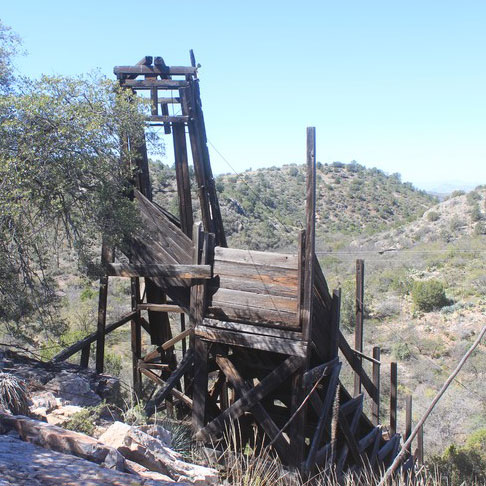 |
The Aravaipa Townsite and Landsman Camp
 |
The ghost town of Aravaipa is located in the western foothills of the Santa Teresa Mountains approximately 10 miles northwest of the small community of Klondyke. The first mining claims were filed in the 1870s.
In the 1890s, the Aravaipa Mining Company added 8 new buildings to the town. These included a post office, several dormitories, a large dining hall, and a stone residence for the mine superintendent, Harry Firth. This period of development was the first of three surges that occurred in the town's history.
The Aravaipa Camp, as it appeared in 1894, is shown in this photo. The Firth residence is the lighter colored building.
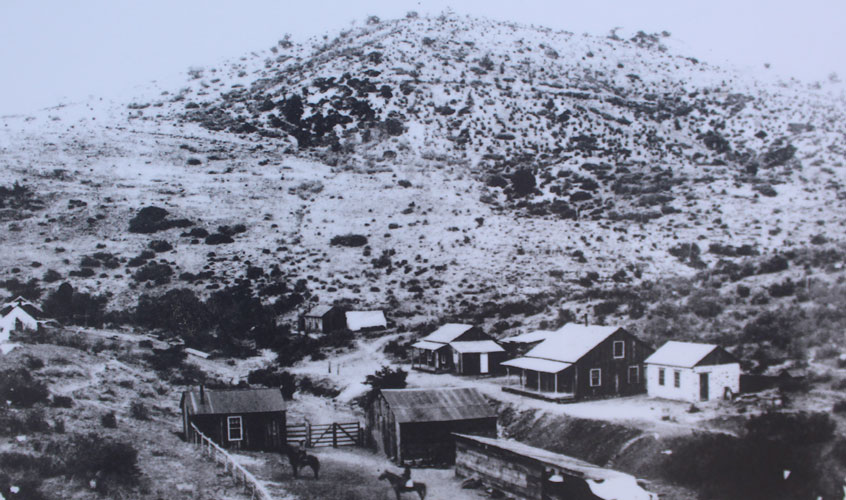 |
This photo was taken in 2017. The original Firth residence is to the right.
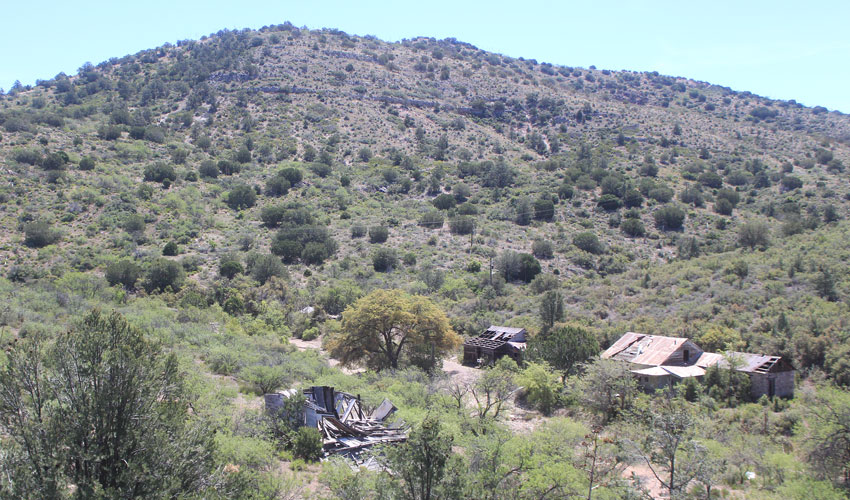 |
From the outside, the Firth house looks very similar today as it did back in the 1890s.
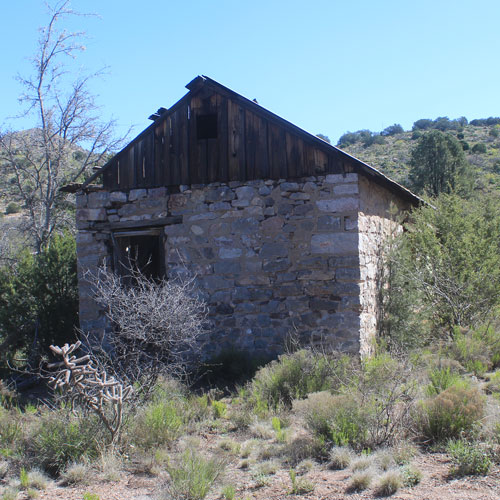 |
It may have been in the 1940's that the Firth residence became an addition to the building next door.
Is the building adjacent to the Firth house the same one that is in the 1894 photo?
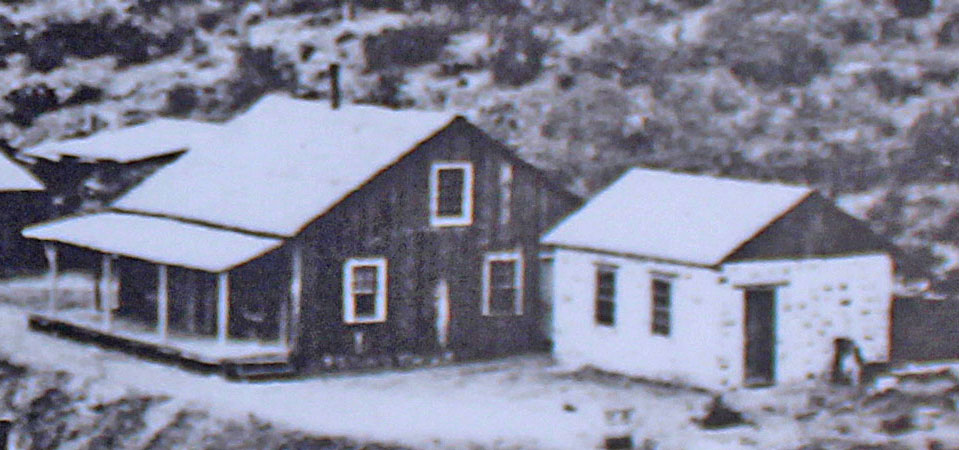 |
The photo below is the front of the adjacent building as it appeared in 2017. The 2nd photo below is the building as it looked when we were here in the 1990s. Although the 1894 photo and the two more recent ones show buildings that are very similar, the arrangement of the windows and the door along the front side give me the impression that the "modern" photos are of a larger building. Perhaps there was some serious remodeling done to the original structure?
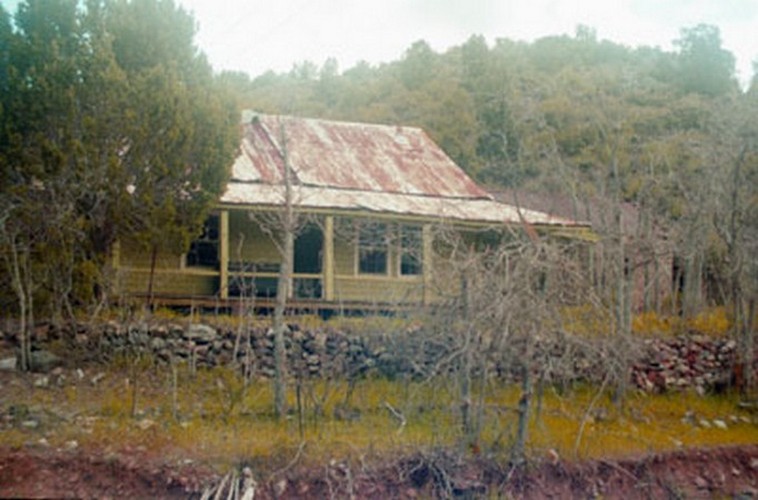 |
The exterior walls of the old stone house are very thick. An active hive of bees in the ceiling discouraged any closer inspection.
The interior of the "main" house looks like one that would have been found in town not one located at a remote mine site.
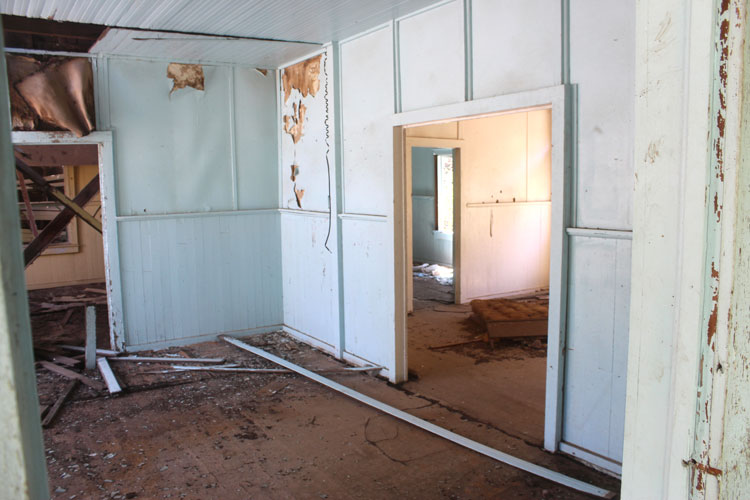 |
The first electrical power available came from a generator located behind the manager's house. In the late 40s or early 50s, a power line was run through Aravaipa to a mine several miles north of the town. Drops were made from that line to several of the buildings in the town. The manager's residence was probably the first to receive that service.
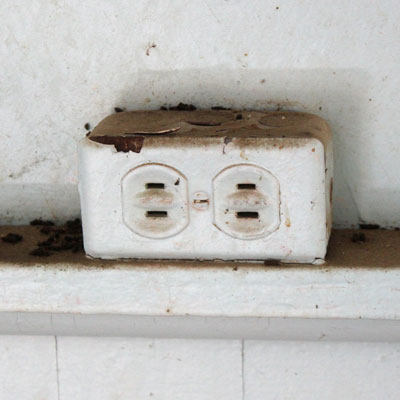 |
A shallow well provided water during the early years of the town. It soon became necessary to supplement that source. Water was transported in wagons from Tule Springs and then transferred to storage tanks at the town site. Later, water was trucked in from the Klondyke Mill. The manager's house had indoor plumbing, the majority of the workers' houses did not.
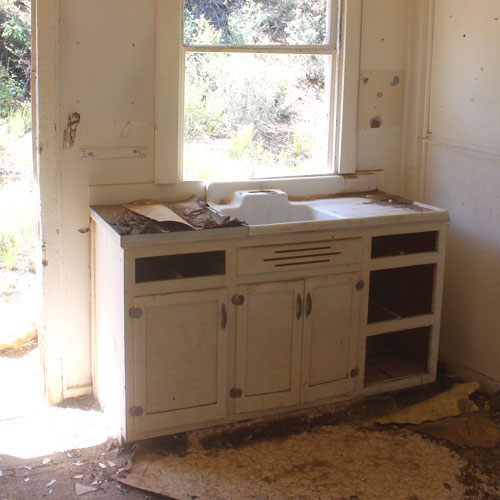 |
This structure has a form that is similar to that of the 3rd building in the vintage photo. The most recent use of this particular building seems to have been as a shop or storage area.
A roof standing over collapsed walls is all that remains of the building that is in the background of the 1894 photo. The trees to the right are known by the names "Tree-Of-Heaven" or Chinese Sumac. These non-native trees are common to many of the mining towns around this part of the state. They are hardy and fast growing. The plants are now considered to be an invasive species.
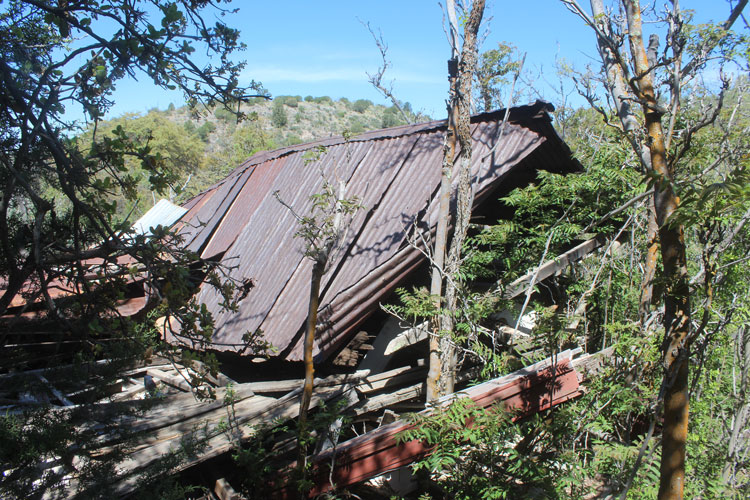 |
The building in the modern photo that is in imminent danger of collapse is shown here. It is not one of the buildings in the 1894 photo. There is a lot of drywall in this structure. so it may date from the late 40s or the 50s? There were supposed to have been 12 buildings left in the town when the last of the mines closed down. There are few signs of that many structures. At its height, the town was supposed to have had more than 30 buildings.
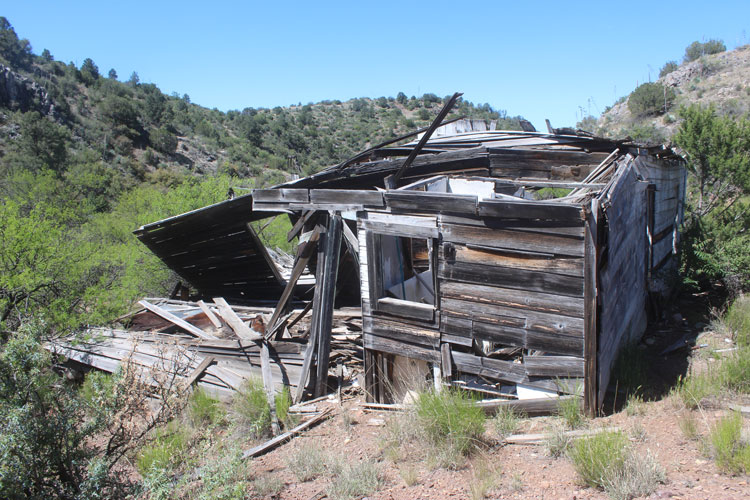 |
The Athletic Mining Company came to Aravaipa from Fort Smith Arkansas in the 1940's. The company developed several mines in the area. That activity was the 3rd and final surge in the town's history. This headframe and ore chute, located east of town, was on one of the AMC properties. Lead and zinc production occurred here from around 1947 to 1957. Initially AMC ore was shipped to the company smelter near Fort Smith. In 1948, a concentrator was built a few miles west of Klondyke. Lead concentrates were then shipped to El Paso and the zinc concentrates were sent to Arkansas
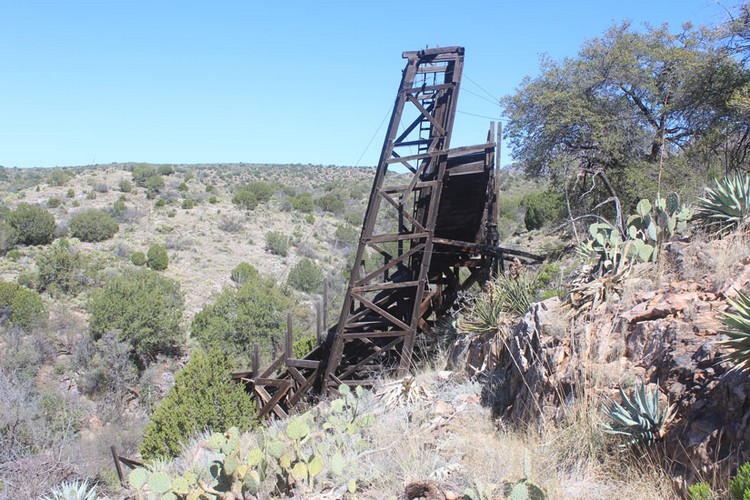 |
A few years ago, a couple of guys rappelled down into the shaft. Their report was that there was some equipment left behind. Unfortunately, the mine had been so wet that the relics were badly rusted. One of their photos is here.
On our 1990s visit, this was the scene at a site just west of the Aravaipa town site. Lead and zinc ores were produced through an inclined shaft. This may have been one of the No 1 Mine sites.
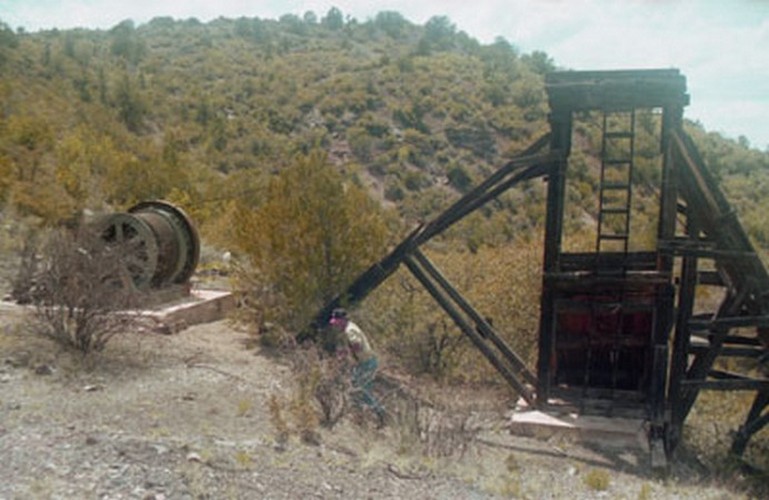 |
The hoist seems to have lost some of its paint, but otherwise appears little changed. The cable still runs to the headframe. The juniper is now a mature tree.
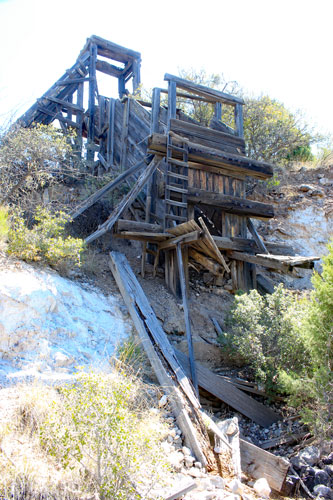 |
Missing from the Aravaipa mining scene, are the old steam boilers that would have been necessary to run the early equipment. These are very common elsewhere. Only one seems to remain in the area of the town site. I have never seen a boiler so thoroughly dis-assembled as this one. Not only were the boiler tubes missing, but the entire shell was gone. Apparently, the local ranchers salvaged the boilers to make into water tanks, fireplaces and other metal objects.
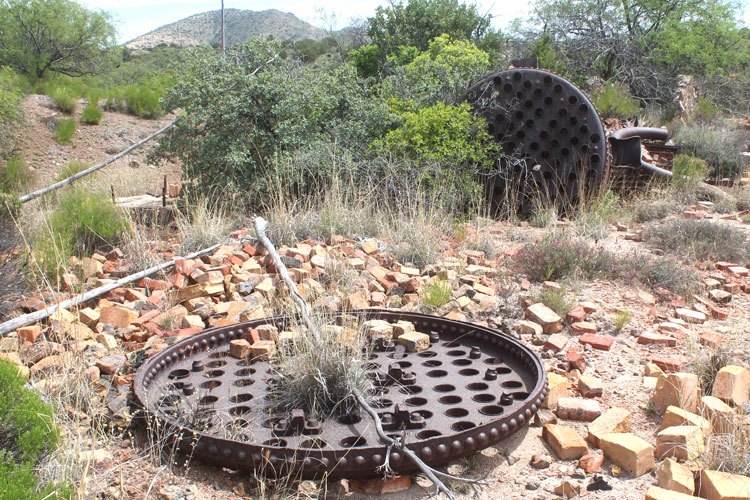 |
 |
This structure may have originally enclosed a pair of boilers. The preference in wood for boiler fuel was oak, mesquite, and juniper in that order. A comparison of the "then" and "now" photos of Aravaipa shows how the native wood supply has rebounded. In more modern times, the mine machinery was powered by gasoline and diesel engines or electric motors.
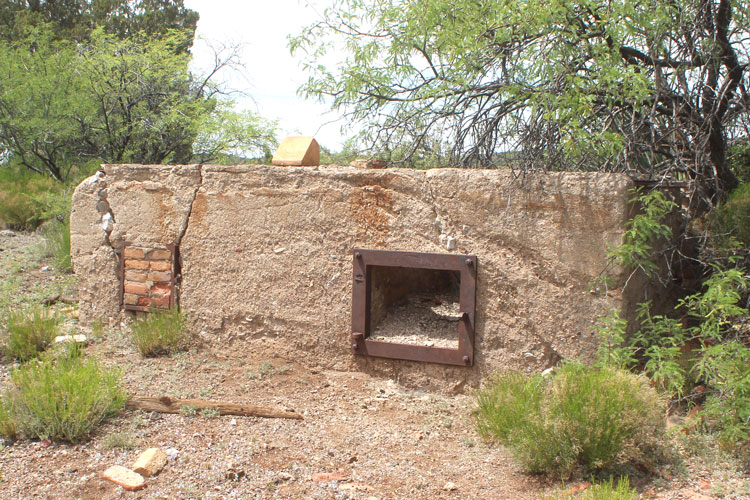 |
Prior to the construction of a small flotation concentrator at Aravaipa in 1926, raw ore was transported to Glenbar, a railroad station on the Gila River between Fort Thomas and Pima. Glenbar was approximately 40 miles north of the Aravaipa mines. From there, the ore was shipped to a smelter in El Paso.
While the concentrating process separated worthless rock materials from the ore minerals, it did not do a good job of separating the zinc minerals from the lead. That affected the price earned when the lead was sold. One report stated that the concentrator worked "through the 1920s". Another noted that the concentrator worked for only a few months before shutting down in 1927. This action may have ended the 2nd surge in Aravaipa's history that had occurred in the mid 1920s. It was in 1927 that the mercantile store in Aravaipa also closed.
These are some of the concrete foundations of the Aravaipa concentrator. The wooden platform is a part of a flotation table that would have been used in the concentration process. The table is upside down. When in use, it would have "vibrated" as part of the process.
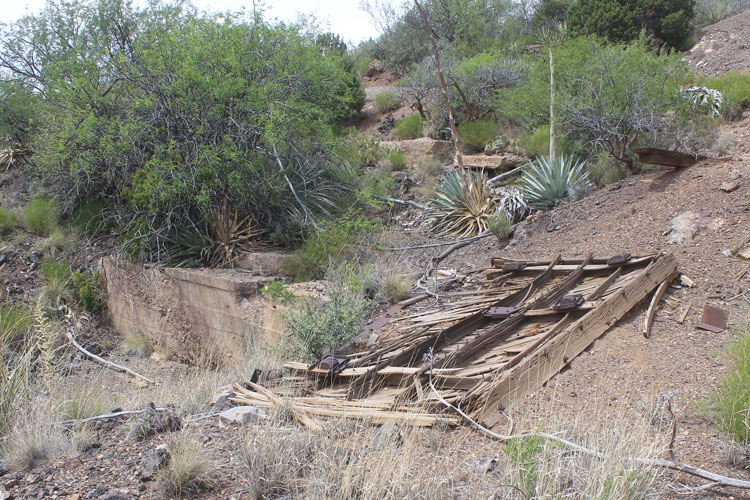 |
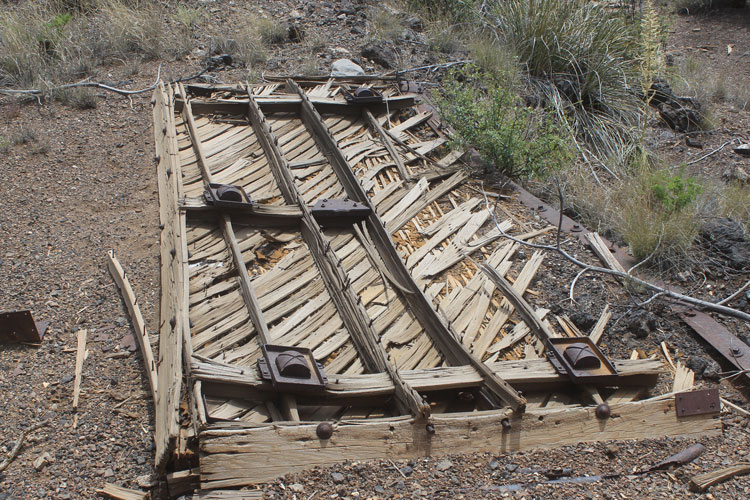 |
Tailings from the concentrator remain .
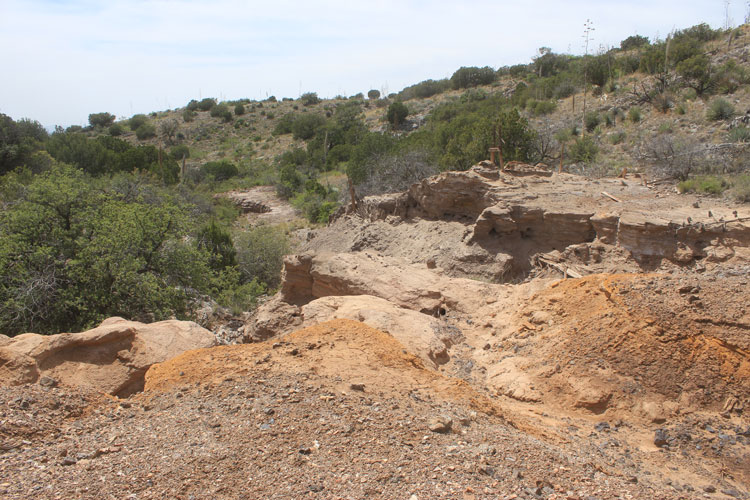 |
Tucked away under a couple of mesquite trees were a pair of interesting ore cars. These cars were gable bottom cars, named for their "W" shaped cross section. The steel plates, shaped like an upside down V, let the cars empty without having to be tipped.
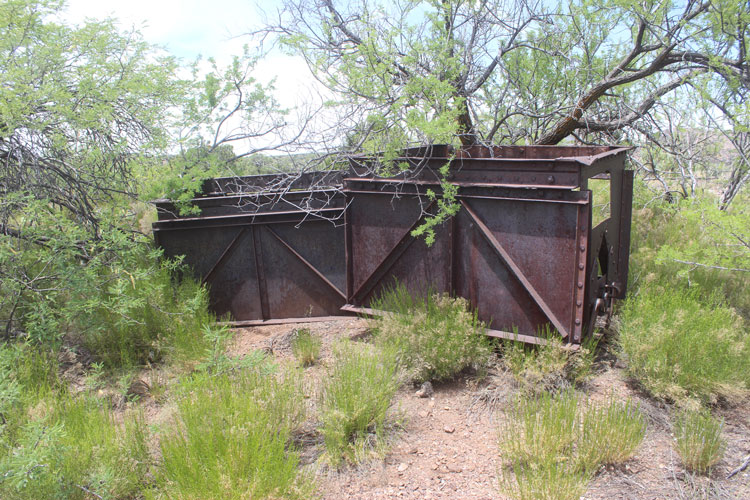 |
The sides of the cars were hinged at the top and could pivot outward.
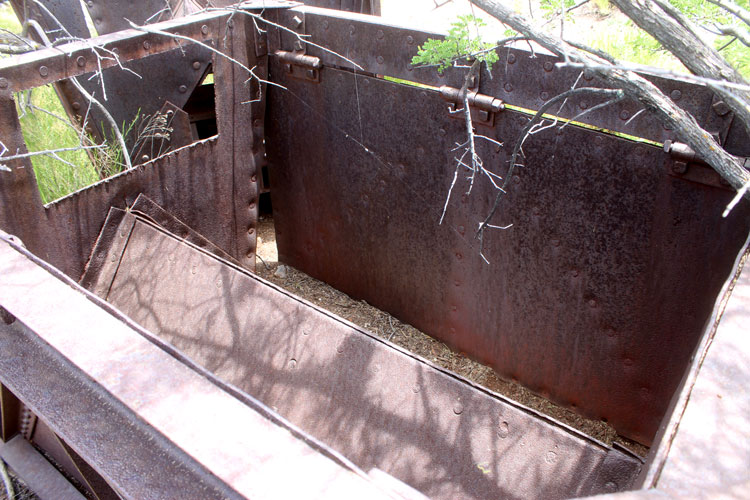 |
When the door latches were released by a trip mechanism located between the rails, the weight of the ore would have forced open the doors and the rock materials would have slipped out and dropped down into a chute or bin beneath the tracks. The holes cut into the panels of these cars suggest that their last function may have been as metal donors for some kind of repair work or fabrication project.
 |
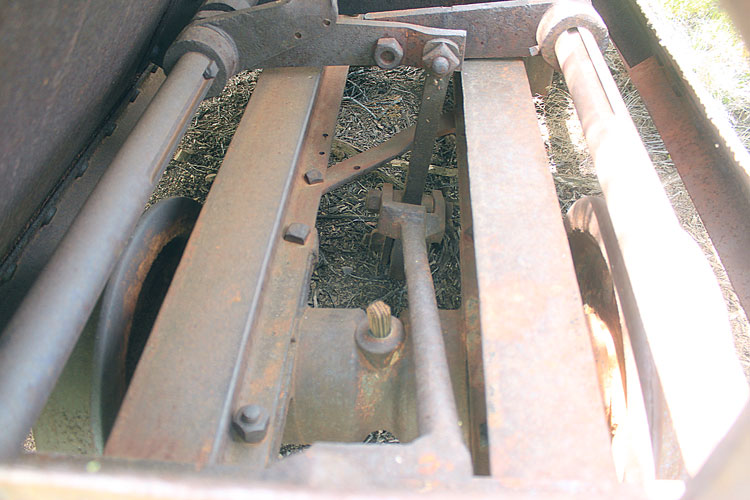 |
This is an interesting dugout. It was made from old barrels that had been cut apart and their shells flattened. How suitable was this for summertime living?
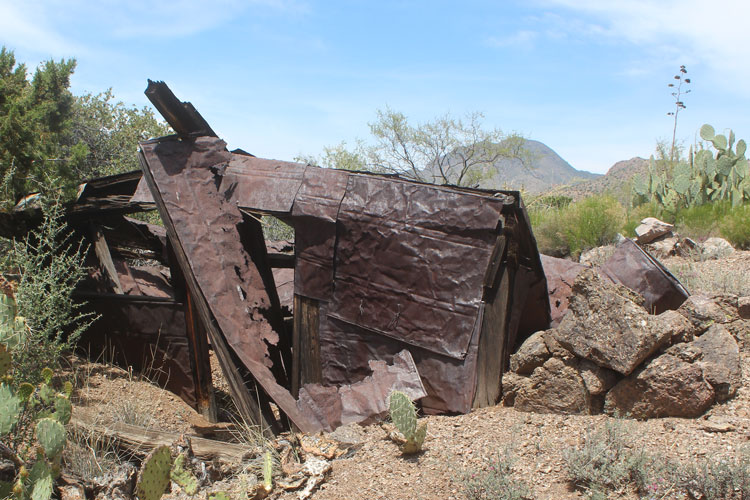 |
 |
In the 1940s and 50s, the Athletic Mining Company also worked properties several miles away from the Aravaipa townsite. One of those was the Iron Cap Mine near Landsman Camp. From the road to Landsman Camp, there are great views to be had in all directions.
To the north, are Stanley Butte on the left and Horse Mountain on the right.
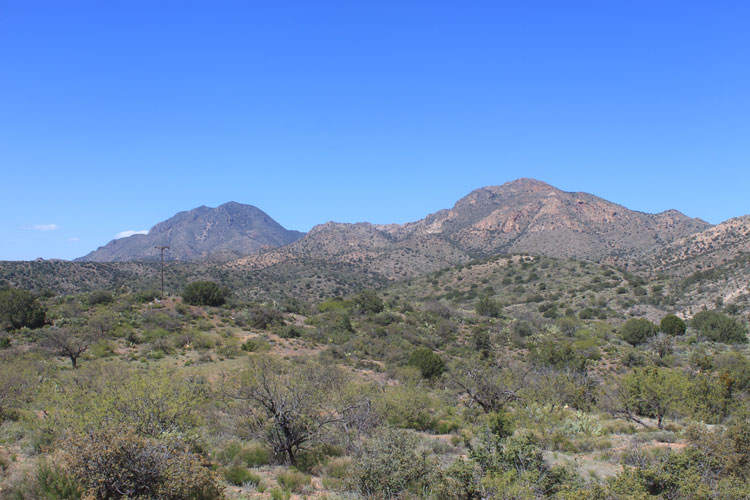 |
Across the Aravaipa Valley, to the south, are Little Table Mountain and Table Mountain in the Galiuro Mountains.
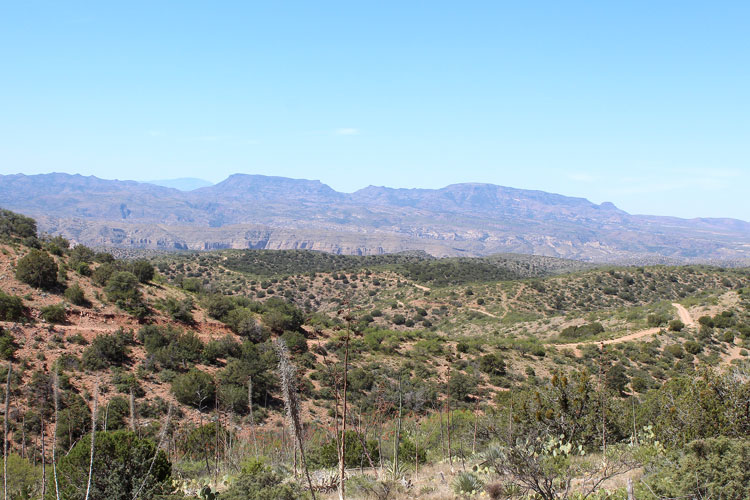 |
And to the east are the peaks of the rugged Santa Teresa Mountains. The shoulder of Imperial Mountain is in the foregound.
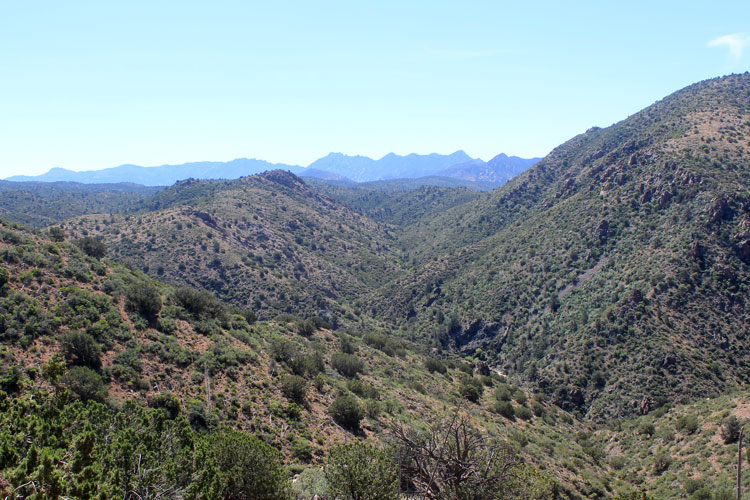 |
Landsman Camp was named for an eccentric prospector named Frank Landsman. His camp was situated near a spring in a grove of Sycamore and Walnut trees. Nothing remains of Landman Camp.
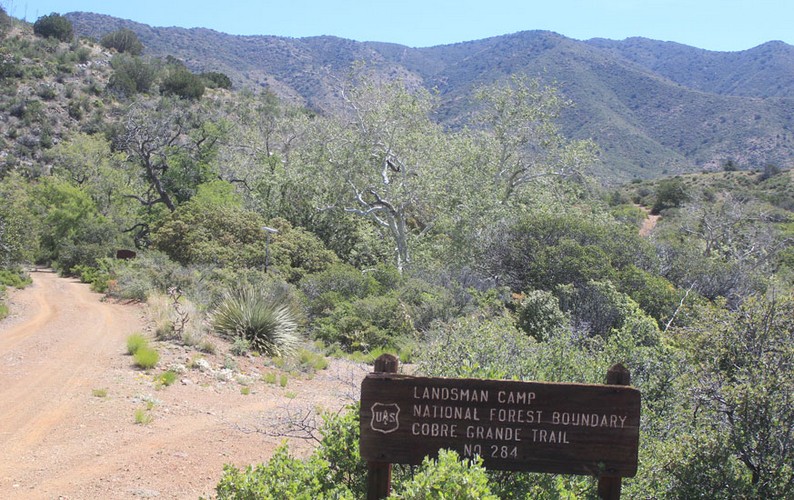 |
This huge Walnut tree is at the old Landsman Camp site. There were many large Walnut Trees that were cut down along the Aravaipa Creek in the 1920s by commercial hardwood cutters.
 |
Not far north of Landsman Camp is the old Iron Cap Mine. Renovated by the Athletic Mining Company in the 1940s, this mine became an important producer for the company. The products were lead and zinc ores with small amounts of silver and copper.
The ores were trucked to the company's concentrator near Klondyke. That was a haul of 15 to 20 miles.
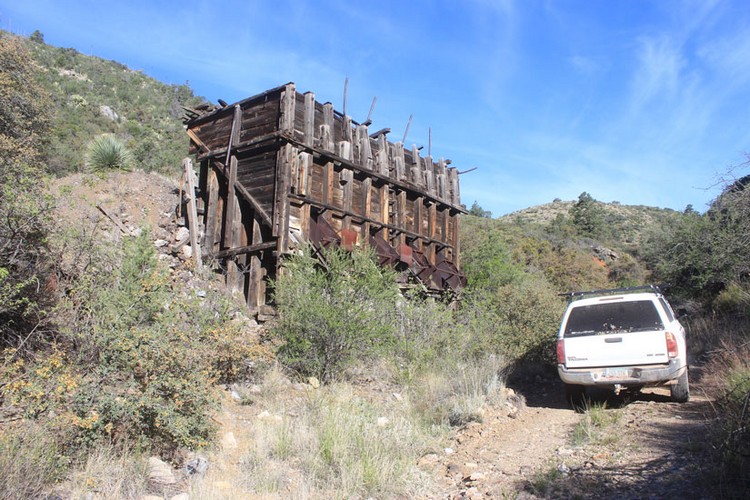 |
These rails once extended back into a long adit. That opening has since caved in on itself.
Higher up on the hillside above the old mine dump is this glory hole. A considerable amount of rock was removed from here. There are 27 different minerals known from this mine site.
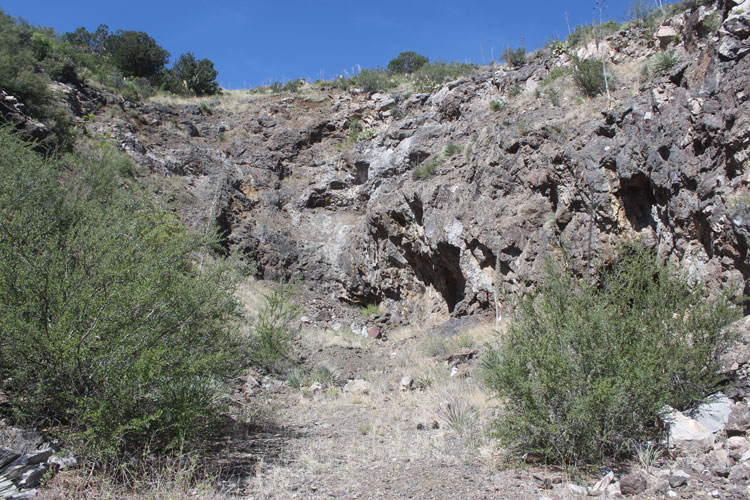 |
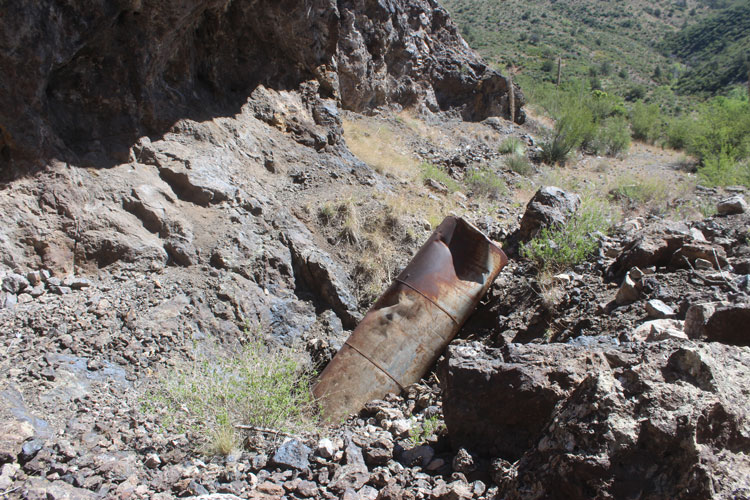 |
I used two references for information on this area. The primary source was a publication from the BLM. Its title is: "Environmental Change In Aravaipa 1870-1970." Particulary interesting and useful was the chapter on mining. I was able to download a PDF version of the document here. Another source of information was "Geology of the Klondyke Quadrangle". That can be found here.
Access to the Aravaipa townsite and the adjacent areas has been problematic in the past. After our visit in the 1990's, we had heard that access had been halted by a land owner whose private property extended across the Aravaipa Road. That closure apparently lasted for several years. I do not know what happened to allow the road to re-open and do not know if it is a permanent situation. This notice was attached to one of the ore bins at the Iron Cap Mine. The ranch named on the notice was involved at one time with the road closure......
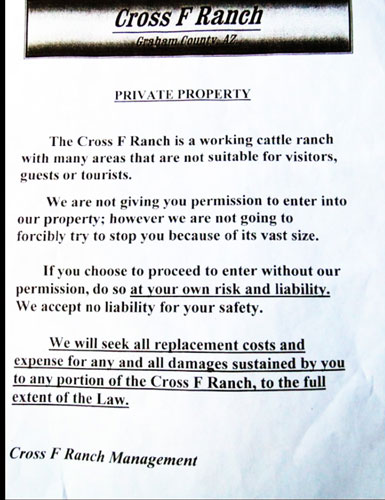 |